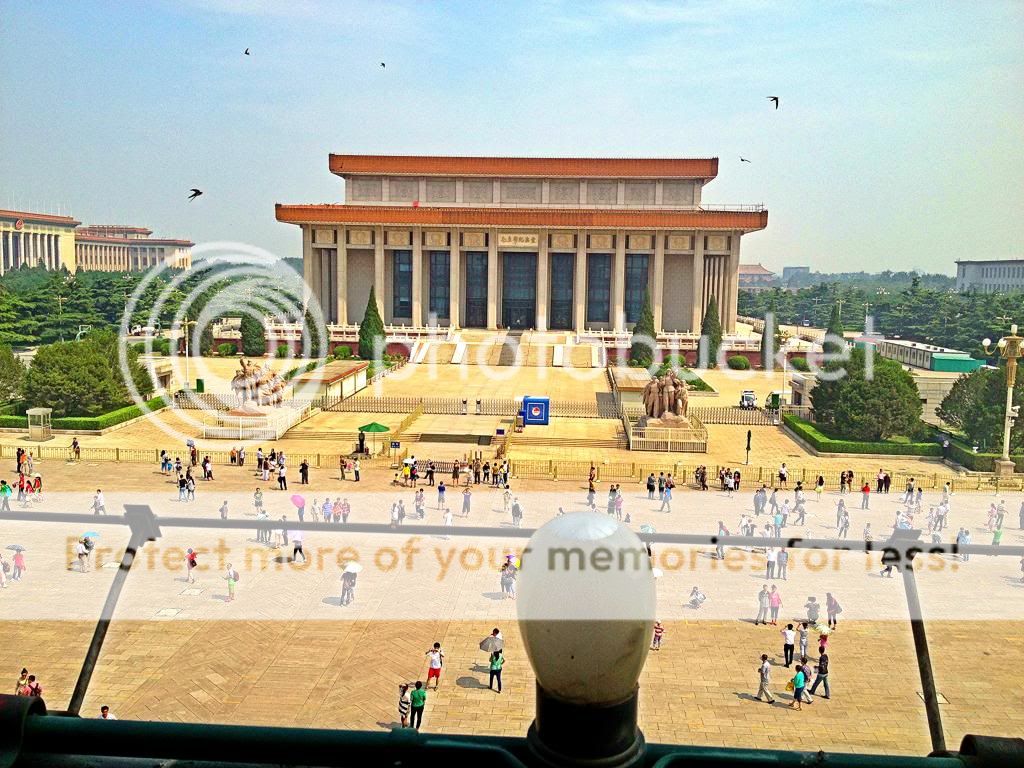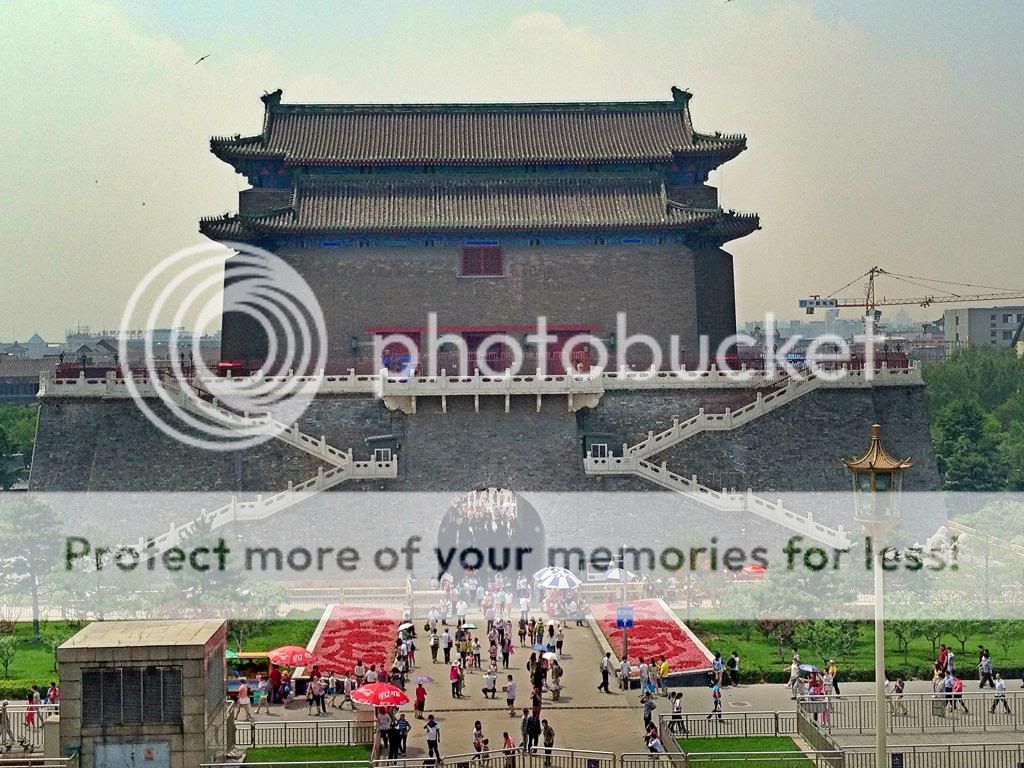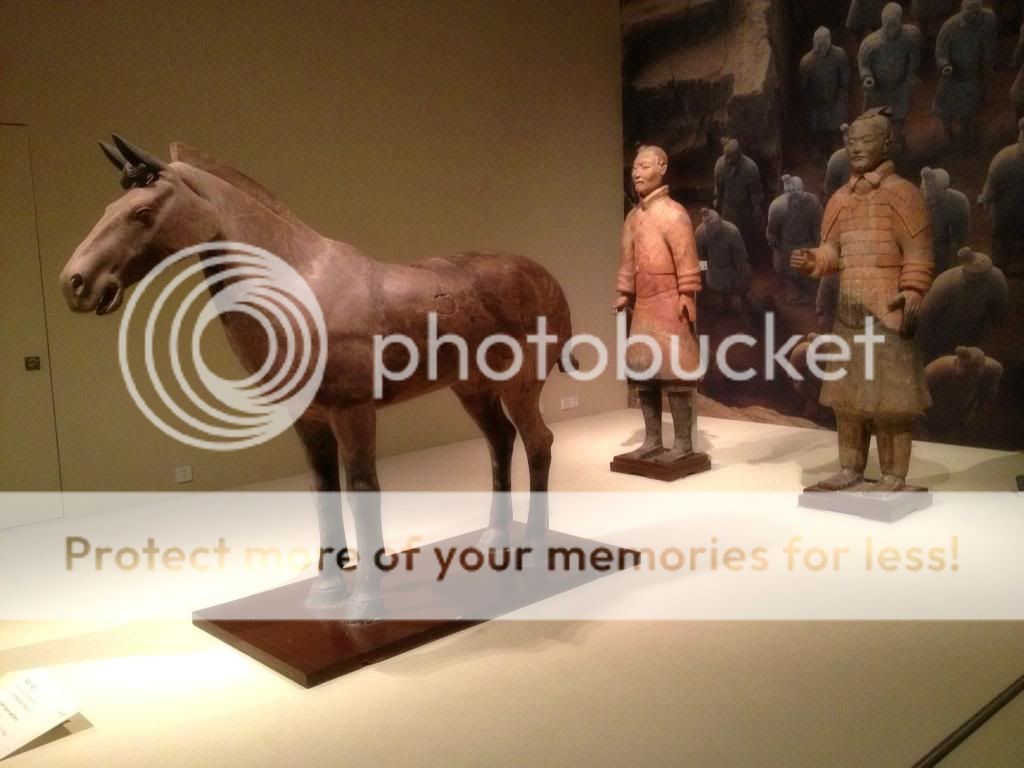On the third and final day of our Beijing trip, we went to Tian'anmen Square and the National Museum of China. These are right next to each other. But then, so is the Forbidden City. Tian'anmen is one of the gates to the Forbidden City and the square is adjacent to the gate. On the other side of the square is Zhengyangmen Gate (Qianmen Gate). Beijing had a series of walls with gates in them. Anmen stands for gate so there are lots of places in Beijing with anmen in them. Beijing, by the way, means northern capital. Nanjing, the previous capital, means southern capital.
We took the metro to the Tianan'men Square station. As soon as we got out of the station and went through the metal detector (being a holiday weekend with lots of crowds, security was very high), we were faced with Zhengyangmen gate.
As it happened, there is a museum at the top of the gate so we went up there and spent some time exploring the history of the gate and of the walls of Beijing. It was also a great place to take photographs.
This is Mao's tomb. We couldn't go inside as it was closed due to the high security.
Looking the other way, this is the old Beijing railway station, which is now a museum.
The main Chinese meridian line goes through Qianmen or Zhengyangmen. It is a broad line through the gate.
It is marked with distances to various places.
Behind the Zhengyangmen gate is the Jian Lou Arrow Tower.
The people figures provide an idea of the scale of these buildings. They are large.
Zooming in, one can see the beautiful flowers at the base. Chinese buildings are decorated with flowers and the gardens everywhere are very well maintained.
Descending to the ground, we started exploring the square. In the middle is the Monument to the People's Heroes. I've seen other monuments to the heroes, they are quite prevalent.
The building behind the monument is the place where the People's Congress meets. One can go in but we didn't. It is the equivalent of the US Capitol.
On this holiday weekend, there were large screens flashing pictures. I don't know if this is on all the time.
There were four of these screens. Two back to back here and two back to back on the other side.
More lovely, manicured flowers and plants.
From the middle of the square, this is a view of Tian'anmen gate. It always has Mao's picture on it and it is where he proclaimed the beginning of the People's Republic of China.
Beyond that gate is the Forbidden City. The last time my husband visited Beijing, one could go through the Forbidden City and exit onto Tian'anmen Square. Now, one can only enter the Forbidden City from the Tian'anmen side and exit on the Jingshan temple side. It helps with crowd control and making sure that no one gets locked into the Forbidden City at night.
China is great at crowd control. Every subway platform has multiple exits. Those winding barriers at airport security points - where you can pull out a strip to section off an area - are everywhere.
The National Museum is right across the street. It is free to enter but you have to show your Chinese identity card or a passport.
The entrance to the museum provides a great view of Tian'anmen Square.
In the museum, we went through a section that described China's fight for self-independence. It definitely had a very Communist slant. But we also saw a lot of galleries with Chinese cultural and historical artifacts.
A preview of a planned trip to Xi'an to see the terracotta warriors:
A gorgeous slipper:
A piece of a sock:
A gallery full of beautiful Buddha figures from China, Tibet and nearby areas:
Lovely ceramics:
And almost at the end, a photo that is not related to this trip but is from Beijing none-the-less.
This is the Olympic park with the Bird's nest stadium in the background. Finally, a view of the National Aquatics Center, also built for the Olympics. People recognize these from the Olympics.
I do have more photos of the Llama temple but I will keep those for another post. Right now I am ready to move on to Istanbul for a change.
We took the metro to the Tianan'men Square station. As soon as we got out of the station and went through the metal detector (being a holiday weekend with lots of crowds, security was very high), we were faced with Zhengyangmen gate.
As it happened, there is a museum at the top of the gate so we went up there and spent some time exploring the history of the gate and of the walls of Beijing. It was also a great place to take photographs.
This is Mao's tomb. We couldn't go inside as it was closed due to the high security.
The main Chinese meridian line goes through Qianmen or Zhengyangmen. It is a broad line through the gate.
It is marked with distances to various places.
Behind the Zhengyangmen gate is the Jian Lou Arrow Tower.
The people figures provide an idea of the scale of these buildings. They are large.
Zooming in, one can see the beautiful flowers at the base. Chinese buildings are decorated with flowers and the gardens everywhere are very well maintained.
Descending to the ground, we started exploring the square. In the middle is the Monument to the People's Heroes. I've seen other monuments to the heroes, they are quite prevalent.
The building behind the monument is the place where the People's Congress meets. One can go in but we didn't. It is the equivalent of the US Capitol.
On this holiday weekend, there were large screens flashing pictures. I don't know if this is on all the time.
There were four of these screens. Two back to back here and two back to back on the other side.
More lovely, manicured flowers and plants.
From the middle of the square, this is a view of Tian'anmen gate. It always has Mao's picture on it and it is where he proclaimed the beginning of the People's Republic of China.
Beyond that gate is the Forbidden City. The last time my husband visited Beijing, one could go through the Forbidden City and exit onto Tian'anmen Square. Now, one can only enter the Forbidden City from the Tian'anmen side and exit on the Jingshan temple side. It helps with crowd control and making sure that no one gets locked into the Forbidden City at night.
China is great at crowd control. Every subway platform has multiple exits. Those winding barriers at airport security points - where you can pull out a strip to section off an area - are everywhere.
The National Museum is right across the street. It is free to enter but you have to show your Chinese identity card or a passport.
The entrance to the museum provides a great view of Tian'anmen Square.
In the museum, we went through a section that described China's fight for self-independence. It definitely had a very Communist slant. But we also saw a lot of galleries with Chinese cultural and historical artifacts.
A preview of a planned trip to Xi'an to see the terracotta warriors:
A gorgeous slipper:
A piece of a sock:
A gallery full of beautiful Buddha figures from China, Tibet and nearby areas:
Lovely ceramics:
And almost at the end, a photo that is not related to this trip but is from Beijing none-the-less.
This is the Olympic park with the Bird's nest stadium in the background. Finally, a view of the National Aquatics Center, also built for the Olympics. People recognize these from the Olympics.
I do have more photos of the Llama temple but I will keep those for another post. Right now I am ready to move on to Istanbul for a change.




















No comments:
Post a Comment